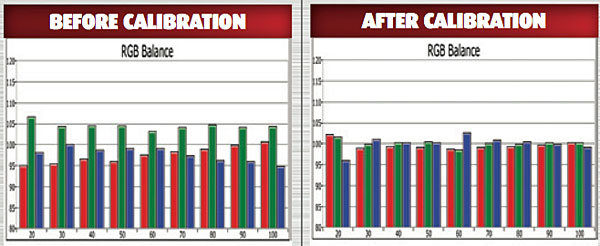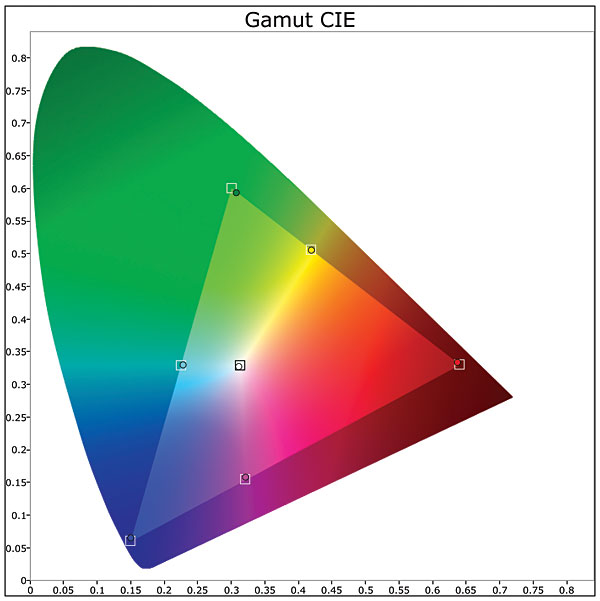Panasonic TC-P55ST50 Plasma 3D HDTV HT Labs Measures
For the control settings used in this review, go to HomeTheater.com. All the measurements here, and all the viewing described in the review, unless noted otherwise, were performed in the Cinema Picture mode for 2D, the Custom mode for 3D, and through an HDMI input with the set adjusted as needed for the most accurate image in a darkened room.
The above 2D contrast ratio was derived from a measured peak-white level of 28.28 foot-lamberts and black level of 0.004 ft-L.
The 2D calibration was performed in the code-locked service menu. Only the Custom Picture mode offers user-menu white balance adjustments, but the fixed gamma in the Cinema mode was judged more appropriate for 2D than any of the six gamma settings available in the Custom mode’s Pro settings menu.
As can be seen in the accompanying charts, the TC-P55ST50’s pre-calibration 2D white balance in the Cinema mode produced respectable results, but the set can do far better. The precalibration Delta E values ranged from 2.1 at 30 percent brightness (good) to 7.85 at 100 percent, with an average of 4.15. Postcalibration, the low was 0.28 at 40 percent and the high 1.27 at 20 percent, with an average of 0.84!

(Delta E is a figure of merit that indicates how closely a display adheres to the HD color standard. Experts generally agree that levels below 3 to 4 indicate a result that’s visibly indistinguishable from perfect color tracking. Delta Es can be used to characterize either white balance (grayscale), as above, or color, as below.)
In the Normal Color space setting, the set’s 2D color gamut (see the CIE chart) was very close to the Rec. 709 HD standard with respect to the locations of the color points. The luminance values of the individual colors were less good, and varied with the white brightness level at which the measurements were taken. But with modest applications of the Color control, only the most highly calibrated eyeballs will find anything to complain about. The overall postcalibration color Delta E values averaged 3.61, with a high of 6.14 for green and a low of 1.81 for yellow.
The Panasonic’s gamma in the 2D Cinema Picture mode averaged 2.13, with a low of 1.93 at 20 percent and a high of 2.46 at 90 percent. It remained between 1.96 and 2.19 from 30 percent to 80 percent.
The Custom Picture mode was used for 3D; despite its very odd gamma (see below) it worked well, as described in the review. All of the 3D measurements were taken through the 3D glasses. In 3D, the full-on/full-off contrast ratio measured 953:1, with a peak white level of 7.62 ft-L and a black level of 0.008 ft-L.
The 3D measurements were less pristine than the 2D results, but were still reasonable. Precalibration, the overall grayscale Delta E measured from a low of 0.707 at 60 percent to a high of 8.18 at 100 percent. Postcalibration, the grayscale produced an average Delta E of 2.44. It exceeded 3.0 only at 60 percent (3.49) and 100 percent (5.13).

The 3D color gamut was not as accurate as in 2D, with several of the color points differing significantly from the HD standard (see the CIE chart). The average 3D color Delta E was 7.45, with a high of 12.42 for red and a low of 4.05 for yellow.

The TC-P55ST50’s 3D gamma uses a lower-than-standard gamma to pump up the midrange brightness region, since most program material lives in this area. With the set’s gamma set to 2.2 in the Custom mode, the average gamma actually measured 1.35, from a high of 1.76 at 20 percent brightness to a low of 0.32 (!) at 90 percent. Even the 2.6 setting produced an average 3D gamma of only 1.66. As noted in the review, this had significantly less noticeable effect subjectively than the numbers would seem to suggest. —TJN








































